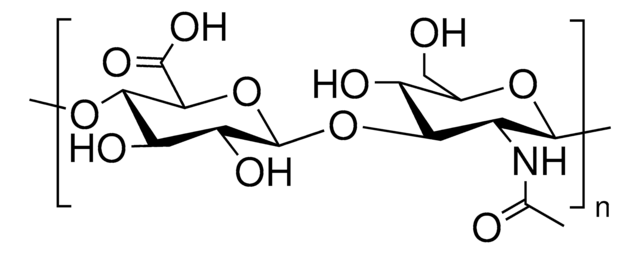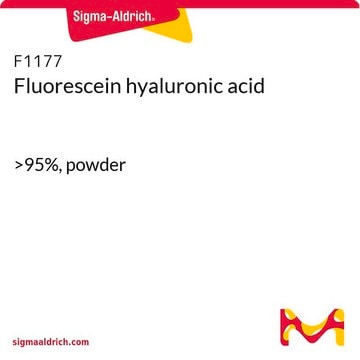If this product has an expiration or retest date, it will be shown on the Certificate of Analysis (COA, CofA). If there is no retest or expiration date listed on the product's COA, we do not have suitable stability data to determine a shelf life. For these products, the only date on the COA will be the release date; a retest, expiration, or use-by-date will not be displayed.
For all products, we recommend handling per defined conditions as printed in our product literature and website product descriptions. We recommend that products should be routinely inspected by customers to ensure they perform as expected.
For products without retest or expiration dates, our standard warranty of 1 year from the date of shipment is applicable.
For more information, please refer to the Product Dating Information document: https://www.sigmaaldrich.com/deepweb/assets/sigmaaldrich/marketing/global/documents/449/386/product-dating-information-mk.pdf
924474
Hyaluronic Acid
Low Viscosity, Low endotoxin
Sinónimos:
3D bioprinting, HA, Hyaluronan
Seleccione un Tamaño
Seleccione un Tamaño
About This Item
Productos recomendados
Nivel de calidad
Formulario
(powder or chunk(s) or fibers)
impurezas
<10 CFU/g Bioburden
<100 EU/g Endotoxin
color
white to off-white
idoneidad
conforms to structure for NMR
temp. de almacenamiento
2-8°C
Categorías relacionadas
Descripción general
Aplicación
- Cell migration
- Angiogenesis
- Viability
- Proliferation
Our low endotoxin HA is tested for both endotoxin (< 100 EU/g) and bioburden (< 10 CFU/g) levels, so you can choose which material is right for your research.
Código de clase de almacenamiento
11 - Combustible Solids
Clase de riesgo para el agua (WGK)
WGK 3
Punto de inflamabilidad (°F)
Not applicable
Punto de inflamabilidad (°C)
Not applicable
Elija entre una de las versiones más recientes:
¿Ya tiene este producto?
Encuentre la documentación para los productos que ha comprado recientemente en la Biblioteca de documentos.
Artículos
Engineered ECMs enhance immune therapy in cancer treatment by supporting cells and tissues and modulating immune response. They improve immune cell maturation, expansion, and regulation through biomaterial manipulation, acting as frameworks or carriers for enhanced tumor immunotherapy.
-
How can I determine the shelf life / expiration / retest date of this product?
1 answer-
Helpful?
-
-
How is shipping temperature determined? And how is it related to the product storage temperature?
1 answer-
Products may be shipped at a different temperature than the recommended long-term storage temperature. If the product quality is sensitive to short-term exposure to conditions other than the recommended long-term storage, it will be shipped on wet or dry-ice. If the product quality is NOT affected by short-term exposure to conditions other than the recommended long-term storage, it will be shipped at ambient temperature. As shipping routes are configured for minimum transit times, shipping at ambient temperature helps control shipping costs for our customers. For more information, please refer to the Storage and Transport Conditions document: https://www.sigmaaldrich.com/deepweb/assets/sigmaaldrich/marketing/global/documents/316/622/storage-transport-conditions-mk.pdf
Helpful?
-
-
what MW range is the HA in this poduct?
1 answer-
The molecular weight of this product is not determined. However, historical data suggests batches typically have a Mn (molecular number) around 20-40kDa.
Helpful?
-
-
How can this product best be reconstituted for surface coating TC substrates?
1 answer-
Unfortunately, this product is not tested for solubility. However, according to the literature, Hyaluronic acid is soluble in water. Dissolve in cold water and shake slowly until the hyaluronic acid is dissolved completely. Please note this has not been validated internally.
Helpful?
-
Active Filters
Nuestro equipo de científicos tiene experiencia en todas las áreas de investigación: Ciencias de la vida, Ciencia de los materiales, Síntesis química, Cromatografía, Analítica y muchas otras.
Póngase en contacto con el Servicio técnico





